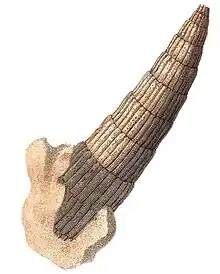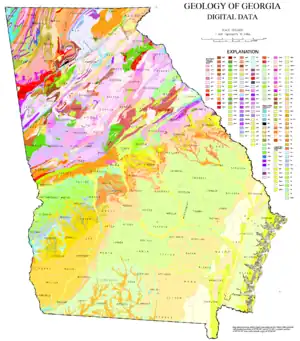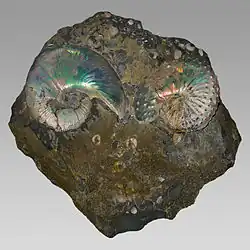The Cretaceous Portal IntroductionThe Cretaceous (IPA: /krɪˈteɪʃəs/ krih-TAY-shəs) is a geological period that lasted from about 145 to 66 million years ago (Mya). It is the third and final period of the Mesozoic Era, as well as the longest. At around 79 million years, it is the longest geological period of the entire Phanerozoic. The name is derived from the Latin creta, "chalk", which is abundant in the latter half of the period. It is usually abbreviated K, for its German translation Kreide. The Cretaceous was a period with a relatively warm climate, resulting in high eustatic sea levels that created numerous shallow inland seas. These oceans and seas were populated with now-extinct marine reptiles, ammonites, and rudists, while dinosaurs continued to dominate on land. The world was largely ice-free, although there is some evidence of brief periods of glaciation during the cooler first half, and forests extended to the poles. During this time, new groups of mammals and birds appeared. During the Early Cretaceous, flowering plants appeared and began to rapidly diversify, becoming the dominant group of plants across the Earth by the end of the Cretaceous, coincident with the decline and extinction of previously widespread gymnosperm groups. (Full article...) Selected article on the Cretaceous world and its legacies Artist's restoration of Psittacosaurus mongoliensis . All species of Psittacosaurus were gazelle-sized bipedal herbivores characterized by a high, powerful beak on the upper jaw. At least one species had long, quill-like structures on its tail and lower back, possibly serving a display function. Psittacosaurs were extremely early ceratopsians. Although they developed many novel adaptations, they shared many anatomical features with later ceratopsians such as Protoceratops and Triceratops. Psittacosaurus is not as familiar to the general public as its distant relative Triceratops but it is one of the most completely known dinosaur genera. Fossils of over 400 individuals have been collected so far, including many complete skeletons. Most different age classes are represented, from hatchling through to adult, which has allowed several detailed studies of Psittacosaurus growth rates and reproductive biology. The abundance of this dinosaur in the fossil record has led to the creation of the Psittacosaurus biochron for Lower Cretaceous sediments of east Asia. (see more...) Did you know?
Need help?Do you have a question about Cretaceous that you can't find the answer to? Consider asking it at the Wikipedia reference desk. Selected image
Selected article on the Cretaceous in human science, culture or economics Geologic map of the US state of Georgia. GeochronologyEpochs - Early Cretaceous - Late Cretaceous Landmasses - Baltica - Gondwana - Laurentia - Siberia Fossil sites - Beecher's Trilobite Bed - Walcott–Rust quarry Researchers - Charles Emerson Beecher - Charles Lapworth - Charles Doolittle Walcott Quality ContentFeatured Cretaceous articles - Bone Sharps, Cowboys, and Thunder Lizards - Bone Wars - Edward Drinker Cope - Geology of the Capitol Reef area - Geology of the Death Valley area -Geology of the Grand Canyon area - Geology of the Zion and Kolob canyons area Good Cretaceous articles - Chitinozoan - Coal ball - Dimetrodon - History of paleontology - Evolutionary history of life - Ornatifilum - Opabinia - Paleontology- Schinderhannes - Small shelly fauna - Temnospondyli - Tiktaalik - Waptia Subcategories Cretaceous Cretaceous by continent Cretaceous geochronology Cretaceous events Cretaceous geology Cretaceous life Cretaceous paleogeography Cretaceous stubs Things you can do
Current Cretaceous FACs - none currently Related contentAssociated WikimediaThe following Wikimedia Foundation sister projects provide more on this subject:
|

